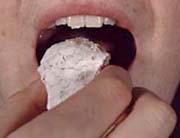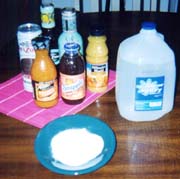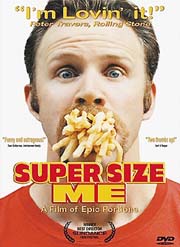 |
||||
|
||||
Are You Gonna Eat That? |
The Live Food Polarity DietImagine a table laden with wholesome, vital foods of every color, texture and taste, from juicy red apples to crunchy golden nuts and perhaps some creamy sesame dressing over rich leafy greens. Sound appealing? All these foods and more are allowed and encouraged in the polarity diet developed by Dr. Randolph Stone. He combined thinking from Ayurvedic, Taoist and Western medicine. Forget the notion of austerity. This diet is vegetarian or light on meats and fish, and it is bountiful. As with other aspects of polarity therapy, foods are classified according to their elemental level. Earthy foods are tubers, bulbs, honey and hard cheese. Watery foods consist of vegetables, greens, melons and milk. Fire foods are grains and cereals, beans, peas and lentils, ginger, garlic and onion. Airy foods are fruits, nuts and cultured dairy products. Ether, the subtle energy of spirit, is a part of living foods and is reflected in the gracious presentation of a meal whether to oneself or others. People require different proportions of these foods according to their elemental makeup, age, health and disposition. Polarity practitioners help folks develop a diet that suits their actual needs and helps ease them out of non-productive habits. Following are some dos and don’ts on digestion and maximizing the value derived from food. This is the way of eating I adopted 20 years ago. Close to the type of common sense diet I grew up with, it places a little more emphasis on food combining. Like anyone, I get lax about self-care, but this is a structure I always return to, and it suits me well. Borrow from it as you see fit. |
Lose Weight while You Quench Your Thirst
Why not have a glass of water if you’re thirsty? A piece of fruit hydrates, nourishes and fills the tummy. Vitamins are best absorbed from the foods they come in naturally, in the forms they come in naturally. Unless your physician or nutritionist tells you otherwise, it’s a good rule of thumb to follow.
That’s why many pediatricians nowadays counsel mothers to avoid juice or mix orange, apple and other juices with water. Otherwise toddlers and young children may become full from all the sugar calories and fail to be hungry for and eat other foods necessary for a well balanced diet.
Now for the good news: Eliminate two servings of bottled drinks — even juice — from your daily diet, and you can lose one pound every nine days — for 40 pounds in one year.
What will you drink instead of those sugar cocktails?
Water is best. Next to that, I like water and lemon or water and a teaspoon of apple cider vinegar, the old New England folk cure that discourages sniffles. To stay warm and relax, drink hot herbal teas, which come in a range of flavors and can be very satisfying. Those teas, black teas and black coffee give you zero calories. Zip. Nada.
The Great Milk Myth
Two cows sing in a pasture: You never outgrow your need for milk. For what? For milk. Drink three glasses every day.
Milk is another drink that’s been advertised and consumed with little restraint. Many people still believe that cows can sing and that milk is the only source of calcium. Not so, says the American Council of Pediatrics. Lots of foods are rich in calcium, and you can safely get your calcium from other sources.
Four ounces of milk give you 150 milligrams of calcium, but at 40 calories for skim milk and 78 calories for whole milk. Four ounces of canned salmon has 220 milligrams of calcium. Sardines do even better: 248 milligrams of calcium in only two ounces. Next to fish and nuts, my favorite source of calcium is greens. One-half cup of turnip greens has 98 milligrams of calcium. The same amount of bok choy (Chinese cabbage) has 79 milligrams. White beans and almonds are also high in this nutrient.
Even so, calcium isn’t the certain solution for strong bones. The Harvard School of Public Health cites factors such as getting enough vitamin D from sunshine and vitamin K from green leafy vegetables, getting vitamin A in natural form and refraining from excessive amounts of caffeine and protein. Exercise too is important.
In other words, it’s body chemistry that matters most. Taking excess calcium without addressing other factors does not improve bone health. In countries such as India and Japan, where calcium intake is about one-third of what’s recommended in the U.S., the incidence of bone fractures is quite low.
Milk has still another drawback. For many people, like my daughter, it’s an allergen. Self-healing guru Dr. Andrew Weil recommends that anyone who suffers from recurring bronchitis, asthma or runny nose should be tested for a milk allergy. From Harvard to Hopkins, a growing number of physicians and nutritionists concur.
Whether milk itself causes mucous production or whether the problem is the work of undiagnosed milk allergies, we can take the common sense approach. Stop all milk products for a few weeks, and you may see less nose dripping, coughing, wheezing and sneezing.
Take Five
God Bless now-retired Giant Foods Consumer Spokesperson O’Donna Mathews, who developed a great slogan and drummed it in our ears for years. Eat five servings of fruit and vegetables a day, she advised, before the new food chart made the advice a national mantra. Consult the updated food pyramid when you’re ready for more information, remembering that new dietary discoveries are made every year.
A simple way to ensure a good spectrum of vitamins is to choose foods in a variety of colors. Eating these foods gives the added benefit of helping us meet our oral drive for sucking, biting and chewing. This instinctive and very physical drive can override the hypothalamus, which tells us when we’ve had enough to eat, becoming a major factor in how much we eat.
Seeing Is BelievingSuper Size Me — A Film of Epic Proportion, filmmaker Morgan Spurlock’s 2003 documentary shows what happens when a man — him
— eats nothing but McDonald’s food for 30 days. Spurlock’s 25-pound weight gain, soaring cholesterol and swollen physique give plenty of food for thought. |
Let Others Eat Cake
Let others eat cake and cookies and drink sodas and other sugary drinks.
What should you eat instead?
Complex carbohydrates such as those in freshly baked wheat and rye breads, rice and even al dente pasta have essential vitamins. Those foods don’t make people fat — though too much of those or any other food will make a person fat. Read Why French Women Don’t Get Fat for refreshing alternatives to America’s never-ending diet fads and consult the new food pyramid to see why carbs should be back in our good graces.
These foods are full of B vitamins. They are essential for healthy skin, hair and teeth. They sharpen mental alertness and smooth out moods. Try your own test. Drive to a bakery (Great Harvest gives samples) for some freshly made whole grain bread. Have a slice and see if the world doesn’t seem a better place.
Eating was once a great pleasure. If we make it so in our own homes, we’ll reduce indigestion and the little purple pills that go with it. Common sense tells us we’re better off looking for the root of indigestion: in the foods we eat, the combinations we eat them in, how fast we eat and whether our meal-time environment is stress free. Do we really need a doctor to tell us these things?
Look Out for Your Family
A middle-aged woman at my church lamented discovering that she had Type II Diabetes and would have to curtail her intake of sugars and simple carbohydrates — the kinds that fill up pizzas, cookies and colas. She served her family a lot of pre-packaged and prepared foods; now that she’d have to go on a special healthy diet, she thought it unfair that her husband and children could continue eating junk food.
A diagnosis like that is a loud wake-up call, not only for one person but also for a whole family. Only one person has become ill so far, but all are at risk. Those skinny teens won’t be that active forever. What happens when sugar calories inside our bodies exceed our physical activities? That overweight husband may have only slightly elevated cholesterol now. How will he fare in a few years?
Why set your children up to be overweight at any age? Why invite diabetes, heart disease and other conditions when you can teach your children to take good care of themselves starting with what they eat?
Think about what is healthy and attractive to you as a start to replacing unhealthy eating habits with positive eating behaviors that you enjoy. One of the first things I do when helping people improve their diets is ask them to make a list of their 10 favorite fruits and vegetables. How many of your favorites are in your refrigerator?
We don’t do well on diets when we’re focused on what we’re giving up. We can maintain a healthy lifestyle by giving ourselves the good things we need and enjoy.
Seven Simple Steps
Here are a few tips to help you bring a healthier you into the New Year:
• Drink plenty of water and other simple, natural drinks.
• Eat whole grains and whole foods when possible.
• If you can’t pronounce a supposed food or beverage ingredient and you don’t know what it’s doing to your body, don’t eat it (unless you’re in a French restaurant).
• Eat five servings of fruits and vegetables daily.
• Eat the required amounts of foods, not many times the required amount.
• Consult the food pyramid, your family physician, allergist and/or nutritionist for expert medical advice and care.
• Beware the snake oil salesman. He’s only in it for the money.
|
Paula A. D. Phillips has worked with thousands of adults and children in movement classes and individual sessions. She is a Registered Polarity Practitioner with 12 years experience working in clinics and healing arts centers where complementary medicine is offered. She is also a former editor of the health newsletter of the American Polarity Therapy Association (www.polaritytherapy.org.) Polarity practitioners encourage a healthy whole foods diet, moderate exercise and a positive attitude as well as employing therapeutic techniques on a treatment table. They challenge their clients and themselves to take responsibility for their own health. |
 |







